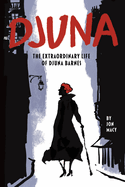
The singular life of one of the United States's unsung literary figures is wondrously illustrated in Djuna, a graphic biography by artist Jon Macy. Most know Djuna Barnes (1892-1982) for her modernist novel Nightwood, published in 1936. Barnes started out as a freelance journalist in Brooklyn, where she gained attention as a "stunt reporter" in the 1910s, famously undergoing a forced feeding to experience what imprisoned hunger-striking suffragettes endured. In the 1920s, she moved to Paris, the hub from which she would go on to rub her dramatically cloak-draped shoulders with the artistic and literary glitterati of the era, including T.S. Eliot, James Joyce, and Peggy Guggenheim. Paris was also where she met the biggest--and last--love of her life: the sculptor Thelma Wood.
Macy constructs his paean in three acts: Barnes's abusive childhood in a polygamous utopian community on rural Long Island, her years writing and loving abroad in Berlin and Paris, and her defeated return to the U.S. after her relationship with Wood ended and her "intentionally lonely life" as a hermit in Greenwich Village began. The muted color palette Macy uses sets off the striking burgundy of Barnes's hair, and his ability to transform Barnes's sublime features into a demonic mask of fury when angered is frighteningly effective.
In Djuna, Macy reveals an extraordinary woman of contradictions: Barnes was a modern woman who longed for stability and privacy, yet craved acclimation and fame. Indeed, "the only label she accepted was genius," Macy observes. Djuna is a superb and long overdue treatment of this fascinating woman. --Peggy Kurkowski, book reviewer and copywriter in Denver

